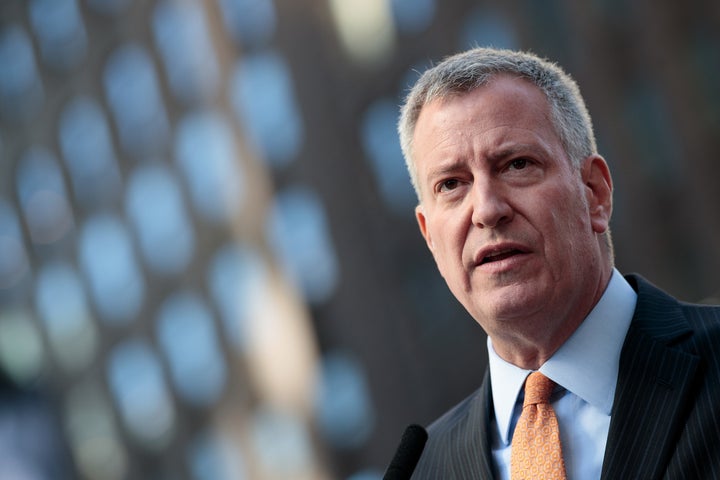
New York City is safer than it has been in decades ― that is, unless you are a victim of domestic violence. While it has seen its homicide rate halved over the past 15 years, murders involving family members and romantic partners have barely budged, NYPD statistics show.
Now, New York City Mayor Bill de Blasio wants to change that. On Friday, he is set to announce the creation of a task force charged with developing an ambitious, citywide plan to tackle domestic violence.
“Violent crime in New York City continues to drop, but domestic violence unacceptably persists,” de Blasio said in a statement to The Huffington Post. “We must do everything we can to ensure that New York City is not just safer overall, but safer for everyone, everywhere, at all times.”
The task force, headed up by newly minted NYPD Commissioner James O’Neil and First Lady Chirlane McCray brings together members of law enforcement and social services, as well as survivors of abuse.
City officials described the goals of the task force as preventing violent crime, making it easier for victims to report abuse, stopping repeat offenders and increasing the conviction rate for prosecutions.
Cecile Noel, commissioner of the Mayor’s Office to Combat Domestic Violence, said the task force would be evaluating innovative strategies from across the country to develop the best approach for the city. After 150 days, the group will present a comprehensive plan to move forward.
As violent crime has fallen in New York City, domestic abuse has made up an increasingly larger share of the remaining violence. In 2015, almost one in every five homicides in the city involved a family member or romantic partner, according to NYPD statistics. And it’s not just murders: Elizabeth Glazer, director of the Mayor’s Office Of Criminal Justice, said domestic violence now accounts for 40 percent of all assaults in the city.
Many experts believe domestic violence homicides can be predicted and prevented, as long as assaults are reported before they escalate and authorities have a chance to intervene. But in New York City, most victims don’t have any contact with police in the year before their death. That’s an issue the task force is likely to address.
Liz Roberts, deputy CEO and chief program officer at Safe Horizon, which provides services for domestic violence victims, said there are many reasons why victims may not report abuse. These include fear of retaliation by the abuser, the threat of deportation for themselves or loved ones, mistrust of the police, and concerns about loss of income or housing.
“Our systems are not yet effective enough in counteracting these barriers,” she said.
McCray said the group would center policies that protect the victim’s critical needs, such as housing and financial security, so that it’s easier and safer to come forward.
“Domestic violence is often just one of many injustices heaped upon the victims of abuse.”
The city has already taken some steps to do so. Last month, the mayor introduced legislation that would allow domestic violence survivors to take paid leave to attend to their safety needs ― without worrying about losing their job. And the city is making housing lawyers available to domestic violence victims for free.
“Domestic violence is often just one of many injustices heaped upon the victims of abuse,” McCray said in a statement. “Homelessness and dislocation from community social supports, loss of jobs, changes in schools and other stressors are unfair and traumatizing.”
The task force will also address why the conviction rate for domestic violence prosecutions ― which is under 33 percent in four out of five boroughs ― is so low.
Maya Raghu, director of workplace equality at the National Women’s Law Center, said it can be disheartening for victims to see so few cases successfully prosecuted.
“It can create fear and distrust of the criminal justice system, and discourage survivors from reporting in the first instance, or cooperating with the prosecution,” she said.
Judy Harris Kluger, a former judge in New York State and executive director of Sanctuary for Families, an organization providing services for domestic violence victims, said it’s very common for cases to be dismissed because the victim doesn’t want to testify.
“In most of these situations, they are the only witness to the incident,” she said, making it hard to prosecute. “There can be fear to go forward; the abuser may have threatened her or the children. Sometimes it’s financial ― if you go forward with the case, it may interfere with his ability to make money.”
Kluger said the practice of evidence-based prosecution, in which a prosecutor tries a case without a victim’s testimony and instead relies on independent corroborative evidence, may help improve outcomes.
“There are ways to build a case even when you don’t have a victim,” she said, “but that requires more tools for the prosecution and the police.”
The task force is also charged with taking a big picture view and identifying ways to prevent violent behavior before it starts ―by intervening with youth.
Research has found that children who are exposed to domestic violence are more likely to grow up to abuse others or be victims of violence themselves.
“It’s sadly an intergenerational issue: young boys who see this as solution to conflict are going to repeat that in their lives,” Kluger said.
She cautioned that domestic violence has different root causes than other types of violence and requires a specialized approach.
“One can’t simply reduce domestic violence by saying we will have more police on the streets,” she said. “By and large, the victims of domestic violence are women, and we are still a patriarchal society. We have to change a lot of things societally.”
______
Melissa Jeltsen covers domestic violence and other issues related to women’s health, safety and security. Tips? Feedback? Send an email or follow her on Twitter.
______
Related stories:
- This Is Not A Love Story: Examining A Month Of Deadly Domestic Violence In America
- Why Didn’t You Just Leave? Six Domestic Violence Survivors Explain Why It’s Never That Simple
- It’s Time We Listen When Women Say Their Boyfriends Are Dangerous
- This Is How A Domestic Violence Victim Falls Through The Cracks
- Men Offer Abhorrent Excuses For Killing Women. Don’t Repeat Them.
- We’re Missing The Big Picture On Mass Shootings
- A Legal Loophole May Have Cost This Woman Her Life
- This Woman Is On Trial For Killing A Man She Says Tried To Kill Her
- Woman Accused Of Murdering Her Abusive Ex Goes Free After Almost 3 Years Behind Bars
